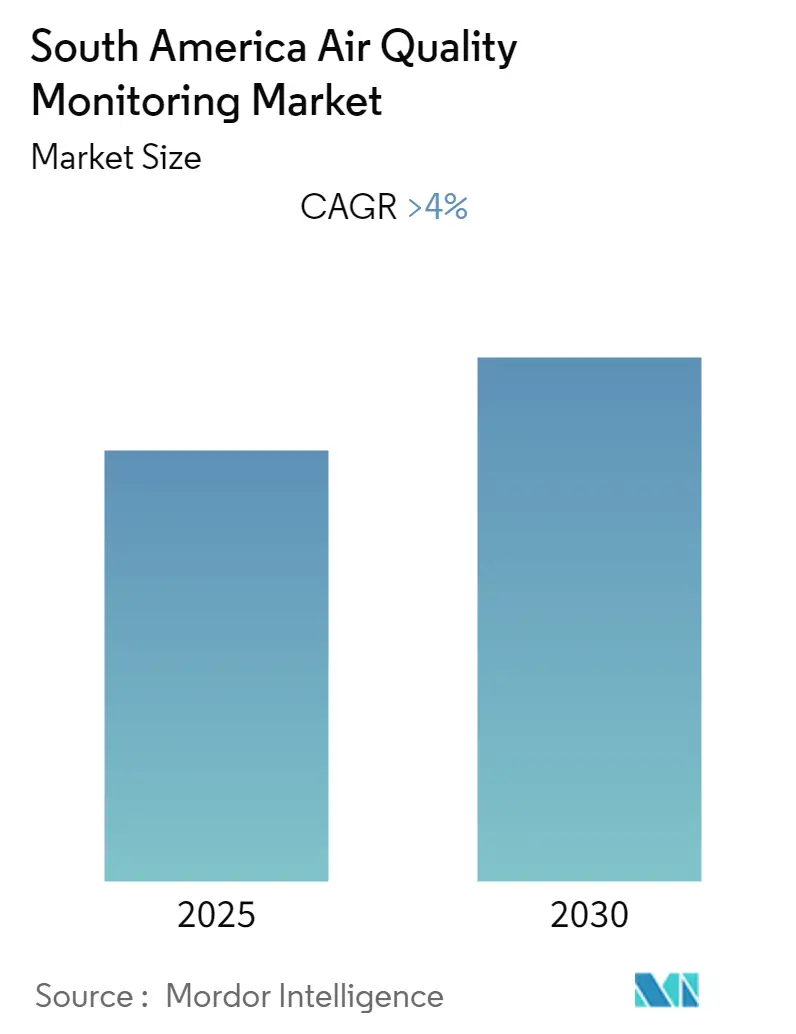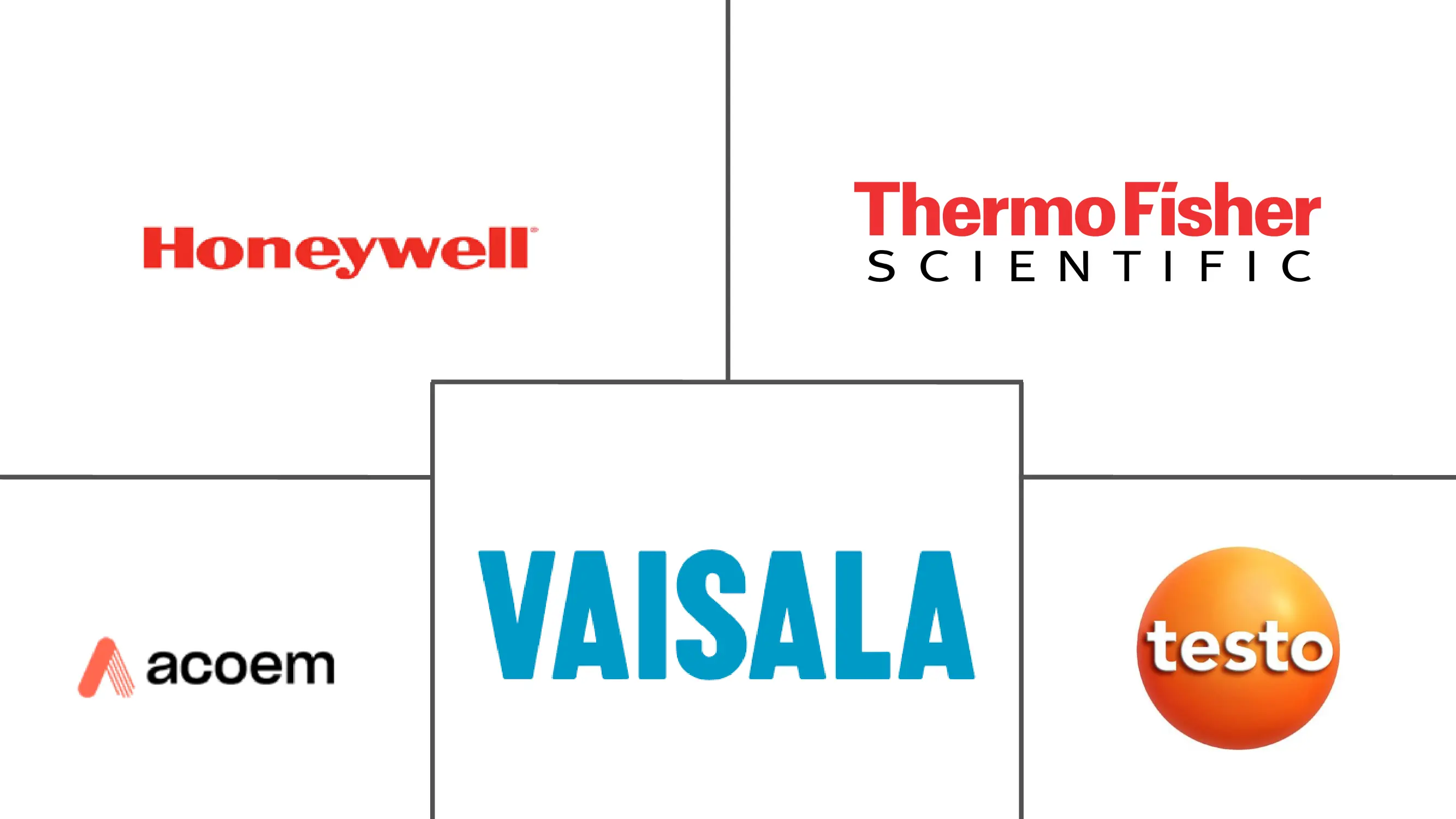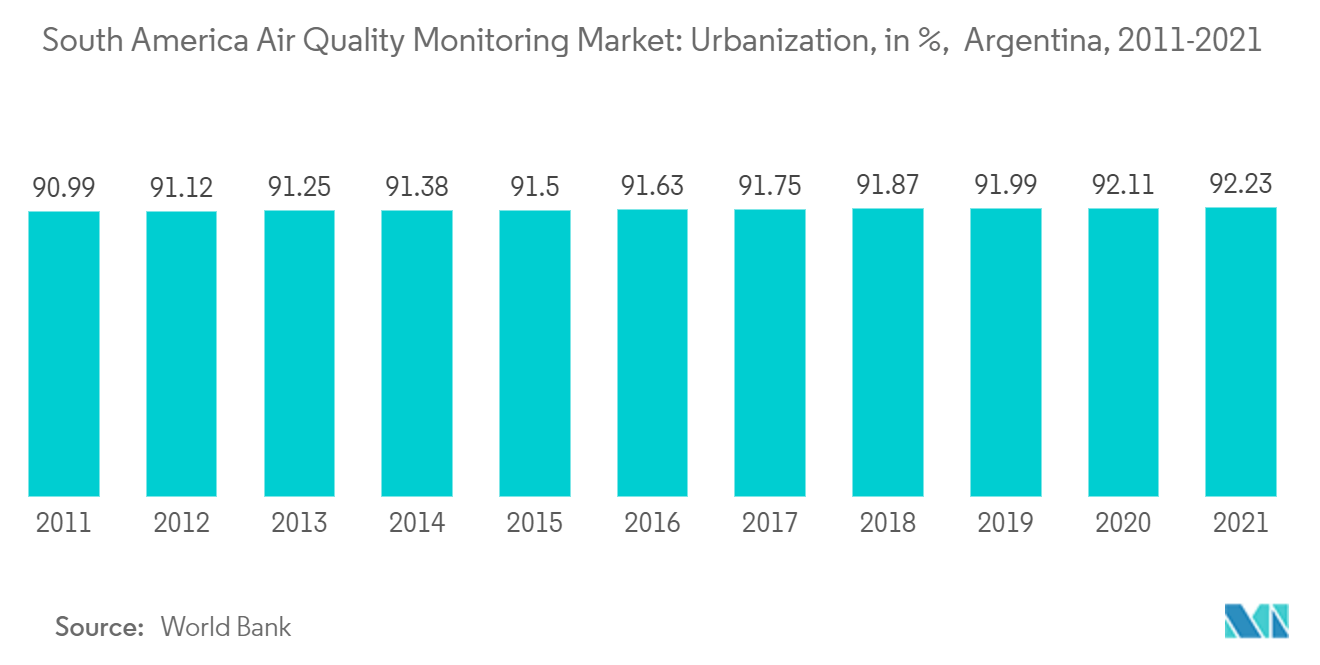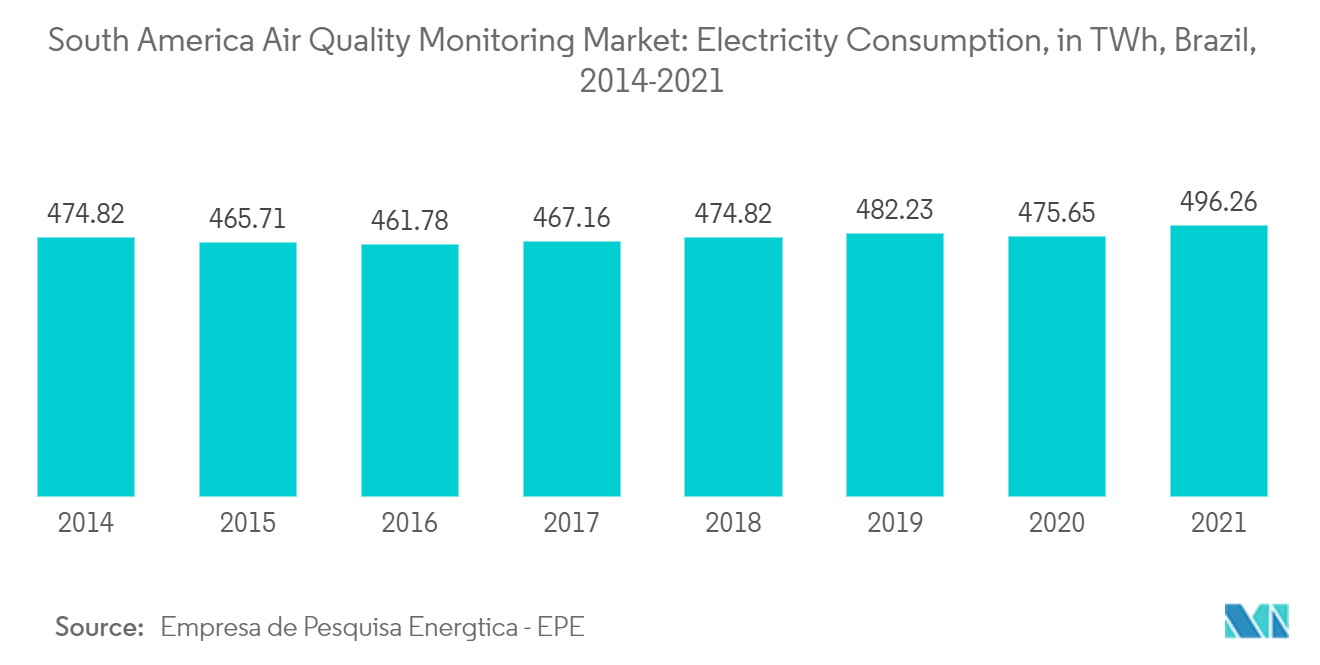South America Air Quality Monitoring Market Size

| Study Period | 2020 - 2030 |
| Base Year For Estimation | 2024 |
| Forecast Data Period | 2025 - 2030 |
| Historical Data Period | 2020 - 2023 |
| CAGR | 4.00 % |
| Market Concentration | Medium |
Major Players
*Disclaimer: Major Players sorted in no particular order |
South America Air Quality Monitoring Market Analysis
The South America Air Quality Monitoring Market is expected to register a CAGR of greater than 4% during the forecast period.
COVID-19 negatively impacted the market. Presently the market reached the pre-pandemic levels.
- Over the medium term, the market will accelerate shortly due to growing concerns about air quality and the expansion of industrialization across many countries.
- On the other hand, the penetration of cleaner energy sources, such as renewable and nuclear energy, is expected to hinder the market's growth due to a steadily declining demand for the product.
- Nevertheless, technological advancements in air quality monitoring systems provide significant opportunities for developing devices and applications based on the technology. IoT-based equipment, which operates interactively and uses new technologies to communicate and deliver data, is in vogue.
- Brazil dominates the market and will likely witness the highest CAGR during the forecast period. This growth is attributed to the increasing urbanization and industrialization in the country.
South America Air Quality Monitoring Market Trends
Indoor Monitor Segment to Witness Significant Growth
- Continuous data about your air's particles, gases, and chemicals are gathered during indoor air quality monitoring. These data are collected to identify trends and problem areas and make necessary adjustments. In addition to reducing airborne disease risks, facility managers and technicians can introduce air quality monitoring to determine which areas affect occupant well-being and detect anomalies like mold growth.
- In contrast to outdoor air, indoor air tends to be continuously recycled, which causes pollutants to accumulate within these confined spaces and trap them. People spend 90% of their time indoors. Indoor air quality (IAQ) refers to various environmental factors within buildings that can affect human health, comfort, or performance. Several factors contribute to indoor air quality, including pollutant concentrations, temperature, and humidity. Measuring indoor air quality reduces the health risks associated with poor indoor air quality, creating a safer, more harmonious environment for people to live in.
- As a result of indoor air pollution, inhabitants face significant short- and long-term health risks. Poor indoor air quality can lead to symptoms such as irritation of the eyes, nose, and throat, headache, nausea, dizziness, and fatigue. In some cases, acute and chronic respiratory illnesses can result from exposure.
- As a result of poor indoor air quality at the workplace, productivity can be reduced, absenteeism may occur, and litigation may result. Employers can maintain healthy working conditions for their employees by effectively monitoring indoor air quality and preventing harmful chemicals and pollutants from entering the workplace. It resulted in an increase in retention, improved productivity, and a reduction in absenteeism among employers.
- There is a strong urbanization trend in Argentina. In 2021 more than 92% of the population was estimated to live in urban areas. However, 47.6% of Argentina's urban population is concentrated in only eight agglomerations, with Buenos Aires as the largest. The growing urbanization leads to increasing residential and commercial sectors in the country, thus helping to drive the indoor air quality monitoring system market growth.
- Chile submitted an updated Nationally Determined Contribution (NDC) with a quantitative target to reduce black carbon emissions by 25% by 2030 compared to 2016. According to the long-term strategy, Chile established a national air quality monitoring system and instruments to monitor black carbon. It can estimate long-term trends in black carbon concentrations in the atmosphere.
- Such developments are expected to give a thrust to the indoor monitor segment of the market during the forecast period.

Brazil to Dominate the Market
- As of 2022, the most populous country in South America is Brazil, which topped 201 million for the first time in 2013 and is the fifth most populated country on earth after China, India, the United States, and Indonesia. While Brazil is experiencing a high growth rate that outpaced previous predictions, by 2060, its population is expected to stabilize at around 218 million.
- The continuous degradation of air quality is attributed to the rapid increase in human population, industrialization, deforestation, economic growth, and vehicular emissions. The ever-growing population in the country accelerates greenhouse gas emissions, resulting in a negative impact on air quality. It leads to demand for air quality monitoring sales in the country.
- In Brazil, smart cities also became an important trend in the past decade and grew considerably in the last few years. In a nutshell, a smart city involves the application of technologies to improve urban solutions, such as lighting, water treatment, transportation, and leisure. In Brazil, there is a strong trend towards urbanization, with more than 87% of the population residing in cities by 2021.
- An important feature of smart cities is the provision of a sustainable environment. Real-time smart city air monitoring of various environmental parameters allows the authorities to make informed infrastructure and policy planning decisions.
- In 2021, Brazil consumed 496.3 TWh of electricity, an increase of approximately 4% compared to 2020. According to Empresa de Pesquisa Energética, Brazilian electricity consumption is expected to continue to increase over the next decade, surpassing 582 TWh by 2026.
- In most cases, thermal power plants generate electricity by burning coal. These coal-fired plants violate air pollution standards, causing air pollution to be a major issue. The Brazilian government formulated strict emission regulations to curb the air pollution level caused by industrial areas, greatly affecting the Air Quality Monitoring Market. Therefore, oil & gas and power generation plants must comply with these regulations by deploying air quality monitors to control and monitor the levels of pollutants.
- The total installed capacity of Brazil is 173.2 GW. 84% is from renewable sources, primarily hydropower. 16% of Brazilian electricity comes from thermal resources (coal, gas, oil, nuclear). By 2025, Brazil is expected to add 15 GW of centralized power generation capacity, according to the Ministry of Mines and Energy (MME). A total investment of USD 62 billion is estimated to be made in utilized-scale power generation by 2029, while a total investment of USD 10 billion is estimated for distributed generation within this period.
- The abovementioned factors are expected to drive the air quality monitoring market demand over the study period.

South America Air Quality Monitoring Industry Overview
The South America air quality monitoring market is moderately fragmented. Some of the major players in the market (in no particular order) include Honeywell International Inc, Thermo Fisher Scientific, Vaisala Oyj, Ecotech, and Testo SE & Co. KGaA.
South America Air Quality Monitoring Market Leaders
-
Honeywell International Inc
-
Thermo Fisher Scientific
-
Ecotech
-
Testo SE & Co. KGaA
-
Vaisala Oyj
*Disclaimer: Major Players sorted in no particular order

South America Air Quality Monitoring Market News
- February 2022: Colombia's capital issued an environmental alert as air quality deteriorated. Forest fires that raged for days in Colombia's Amazon put its Andean capital, Bogota, on an ecological alert as poor air quality spanned across the capital. The wind carried smoke from several fires blamed on armed groups about 350 km to the northwest, all the way to the Colombian capital. Bogota Mayor Claudia Lopez announced that over half of the capital's air quality monitoring stations were off the charts for the past 48 hours.
Table of Contents
1. INTRODUCTION
1.1 Scope of the Study
1.2 Market Definition
1.3 Study Assumptions
2. EXECUTIVE SUMMARY
3. RESEARCH METHODOLOGY
4. MARKET OVERVIEW
4.1 Introduction
4.2 Market Size and Demand Forecast in USD billion, till 2028
4.3 Recent Trends and Developments
4.4 Government Policies and Regulations
4.5 Market Dynamics
4.5.1 Drivers
4.5.2 Restraints
4.6 Supply Chain Analysis
4.7 Porter's Five Forces Analysis
4.7.1 Bargaining Power of Suppliers
4.7.2 Bargaining Power of Consumers
4.7.3 Threat of New Entrants
4.7.4 Threat of Substitutes Products and Services
4.7.5 Intensity of Competitive Rivalry
5. MARKET SEGMENTATION
5.1 Product Type
5.1.1 Indoor Monitor
5.1.2 Outdoor Monitor
5.2 Pollutant Type
5.2.1 Chemical
5.2.2 Biological
5.2.3 Physical
5.3 End User
5.3.1 Residential and Commercial
5.3.2 Power Generation
5.3.3 Petrochemicals
5.3.4 Other End Users
5.4 Geography
5.4.1 Brazil
5.4.2 Argentina
5.4.3 Colombia
5.4.4 Chile
5.4.5 Rest of South America
6. COMPETITIVE LANDSCAPE
6.1 Mergers and Acquisitions, Joint Ventures, Collaborations, and Agreements
6.2 Strategies Adopted by Leading Players
6.3 Company Profiles
6.3.1 Honeywell International Inc
6.3.2 Thermo Fisher Scientific
6.3.3 Vaisala Oyj
6.3.4 Ecotech
6.3.5 Testo SE & Co. KGaA
6.3.6 Aeroqual Limited
6.3.7 Clarity Movement Co.
6.3.8 Oizom Instruments Pvt. Ltd.
6.3.9 Airthinx, Inc
6.3.10 Emerson Electric Co
- *List Not Exhaustive
7. MARKET OPPORTUNITIES AND FUTURE TRENDS
South America Air Quality Monitoring Industry Segmentation
Air quality monitoring refers to continuously measuring specific air pollutants, also known as "criteria air pollutants." It is combined with natural background/trace gas monitoring and stationary source emission monitoring to help determine the level of air pollution people are exposed to.
The South America air quality monitoring market is segmented by product, pollutant, end-user, and geography. The market is segmented by product type into indoor and outdoor monitors. The market is segmented by pollutant type into chemical, biological, and physical pollutant types. By end user, the market is segmented into residential and commercial, power generation, petrochemicals, and other end users. The report also covers the market size and forecasts for the South America air quality monitoring market across major regional countries. Each segment's market sizing and forecasts are based on revenue (USD billion).
| Product Type | |
| Indoor Monitor | |
| Outdoor Monitor |
| Pollutant Type | |
| Chemical | |
| Biological | |
| Physical |
| End User | |
| Residential and Commercial | |
| Power Generation | |
| Petrochemicals | |
| Other End Users |
| Geography | |
| Brazil | |
| Argentina | |
| Colombia | |
| Chile | |
| Rest of South America |
Frequently Asked Questions
What is the current South America Air Quality Monitoring Market size?
The South America Air Quality Monitoring Market is projected to register a CAGR of greater than 4% during the forecast period (2025-2030)
Who are the key players in South America Air Quality Monitoring Market?
Honeywell International Inc, Thermo Fisher Scientific, Ecotech, Testo SE & Co. KGaA and Vaisala Oyj are the major companies operating in the South America Air Quality Monitoring Market.
What years does this South America Air Quality Monitoring Market cover?
The report covers the South America Air Quality Monitoring Market historical market size for years: 2020, 2021, 2022, 2023 and 2024. The report also forecasts the South America Air Quality Monitoring Market size for years: 2025, 2026, 2027, 2028, 2029 and 2030.
South America Air Quality Monitoring Industry Report
Statistics for the 2025 South America Air Quality Monitoring market share, size and revenue growth rate, created by Mordor Intelligence™ Industry Reports. South America Air Quality Monitoring analysis includes a market forecast outlook for 2025 to 2030 and historical overview. Get a sample of this industry analysis as a free report PDF download.



